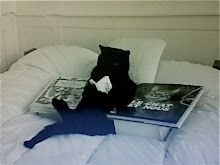It took me a long time to come to terms with Egon Schiele. Much of his art repelled me (still does, to be honest) because of its voyeurism and obtrusive sexualization of little girls.
Much of his art is like a magnet, though. There is an expressive economy of lines in his sketches: there always appears to be enough, though it seems he drew only what was absolutely necessary to make the image legible.
The perspective is often difficult to figure out--sometimes it seems we're looking at the figure from an uncomfortable position at the ceiling, sometimes it seems we're crouching on the floor--but we're always close, in the model's personal space. So close that it's possible to feel like an intruder in a Schiele painting.
When I found KatColorado's re-enaction of Schiele's Sitting Woman... on Flickr, it got me thinking about that problem of intrusiveness and of tableaux vivants (one of those pastimes I can never understand).
I don't mean to go all Marie Bonaparte* on Schiele, but having read about his troubled relationship with his mother, his use of his sister Gerti and then later Wally Neuzil and the Harms sisters as models, I can't quite separate that knowledge from the violence in his representation of women. The photographer re-enacting the painting isn't putting herself just in the position of the model but in multiple roles at once. Unlike in the haunting description of tableaux vivants in The House of Mirth, the issue here is not exact embodiment of the figure in the painting but re-doing the painting. (So KatColorado can survive the experiment, unlike poor Lily Bart?)
It leaves me still not understanding tableaux vivants but more at ease with the masochistic appeal of Schiele's work. I like the photograph. If you know more projects of this kind, drop me a line.
 |  |
*Marie Bonaparte was a disciple of Freud's and author of a psychoanalytical interpretation of the life and works of Edgar Allan Poe, notorious for its vision of art as symptom of the artist's psychological issues.




2 comments:
tried to post this comment earlier, Misiula, but being new to blogging don't know if i succeeded or what, so just in case, here it is a second attempt:
I know the ambivalence. Strangely, for me, I was looking at Schiele’s work just as the story of Joseph Fritzl broke and Der Spiegle of May 05, 2008 felt obliged to defend journalism by contending that questions “ are not offensive, despite Austrian Chancellor Alfred Gusenbauer's complaints about how the international media are portraying this as the latest blemish to his country's name and his insistence that it is "not an Austrian phenomenon." ... If there is truly a question that takes us to the core of this crime, it is this: What does this isolated case have in common with other isolated cases, and what does the perpetrator, Josef Fritzl, have in common with other perpetrators?”.
This somehow confabulated with that other Austrian ‘perpetrator’ foremost in mind at the time, Egon Schiele, very much colouring my response to his work at the time – admiration for his edgy line, admiration for his frank self-revelation, but disquiet at the trade in paedophile images he conducted with wealthy Viennese businessmen, and the exploitive abuse of working class girls he used as models until he was sprung by the scandalised parents of middle class girls recruited to his studio. And my gall rose afresh at the hypocrisy of the plush but repressed Viennese Belle Epoque which fed on the Egon’s images, and then went for good lie-down on Freud’s couch.
And he was such a poseur. So much adolescent attitude. The James Dean of his age, methinks. Numerous photos of him show our Egon striking arty poses, making a fetish feature of his hands, so characteristically rendered in his self-portraits. He did indeed seem to have prehensile fingers. From these photos I developed an iconography of him for a series of paintings – the languid-hooded eye, the sullen lip, the dexterous finger. The plush of darkest Vienna. Egon emerging from the dark – or was he receding into darkness? Egon as Harlequin, paradoxical maker of beauty. Anyway, Peter Schaffer has already dealt with that theme of a devine gift in an unworthy vessel in "Amadeus".
As for those extraordinary, even disturbing poses, I believe Schiele worked from on top of a step-ladder. I think recall seeing a photo of his studio with the step-ladder there. That is how he achieved those dramatic akimbo compositions. Such a master of negative space.
Post a Comment